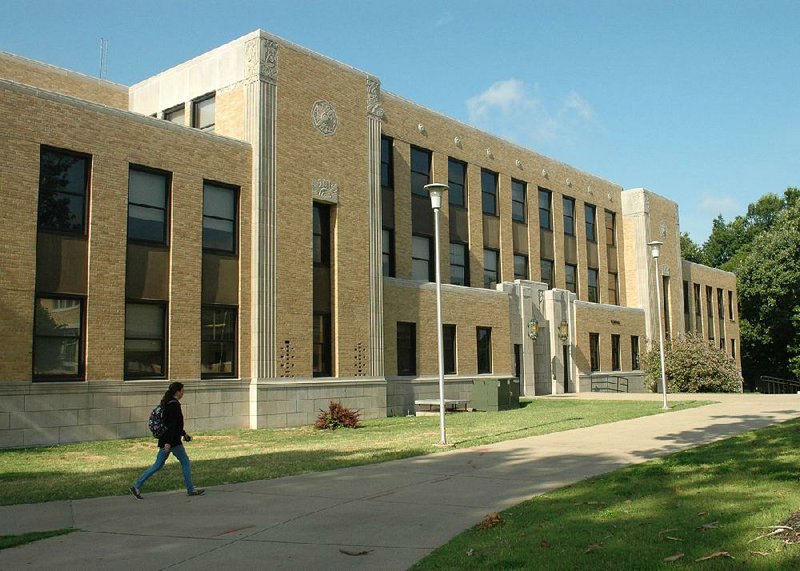JONESBORO -- When workers built R.E. Lee Wilson Hall on the Arkansas State University campus in 1932, they used 16 teams of mules, a McCormick-Deering tractor and a rotary shovel.
The art deco-style building was the centerpiece for the institution, which was known as State A&M College back then. It housed the English and philosophy departments, a 960-seat theater, home economics classes, a post office, a library and the president's office.
Now, more than eight decades later, the building -- rumored to be set for demolition about three years ago -- has returned to the campus's focal point. For the past year, architects and contractors have converted the buff-colored stone building into an 86,000-square-foot osteopathic medical school.
The New York Institute of Technology will lease the facility and offer a doctorate of osteopathic medicine at the Jonesboro campus.
It is the first school of its kind in the state and one of 150 medical schools in the country. The Arkansas College of Osteopathy Medicine will open in Fort Smith next year.
Workers at ASU have added classrooms, training emergency rooms, faux doctors' offices, lecture halls and a third-floor autopsy suite in a building that first opened for classes Nov. 28, 1932.
ASU officials rededicated the building Thursday and announced 124 students will begin classes there on Aug. 8.
Talks between administrators at ASU and the New York Institute of Technology began in 2013.
"When we said we were going to open a medical school in three years, that just boggles the mind," Barbara Ross-Lee, vice president for health sciences and medical affairs at the New York school, said during the dedication ceremony. "But we are addressing a current crisis in health care in this region."
Of the 124 students enrolled for the fall semester, 60 are from Arkansas. There is a waiting list of 150 more, Ross-Lee said.
"You will see the seriousness of our intent," Ross-Lee said. "Within 10 years, we will have 1,000 [doctors] in an under-served area."
She said area hospitals have agreed to provide up to 200 residency positions for NYIT students.
ASU System President Charles Welch said he was enthusiastic when he first talked about his university housing an osteopathic medical school, but he was also skeptical.
"I thought it was unbelievable if we could, but I was not sure how realistic it could be," he said. "We wanted to see what was the right fit for the building. This doesn't just transform our university, but the entire region."
After classes moved from Wilson Hall to the new College of Humanities and Sciences building last summer, the transformation into a medical school began.
Wilson Hall almost never existed, according two ASU professors who chronicled the history of the university in their book Voices from State: An Oral History of Arkansas State University.
Larry Ball and William M. Clements noted in their book that a fire in January 1931 destroyed the college's classrooms. The insurance proceeds were not enough to build a replacement, so trustees arranged a commercial loan to build Wilson Hall for a cost of $350,000.
Because the building sits on land only a few yards west of the burned building, contractors built atop the original foundation rather than removing it. The ceiling of the east portion of Wilson Hall's bottom floor is lower than the rest of the building.
Since 1932, the building was used by many college disciplines. Scores of plays were presented in the theater in the center of the building. Journalism classes wrote articles there for the State College Herald newspaper, and KASU-FM began its operations in a small radio studio inside Wilson Hall on May 17, 1957.
The building also featured open-air courtyards accessible from the hallways. Home economics courses held teas and recitals in the courtyards, teaching students proper serving techniques.
Wilson Hall also housed the original Wigwam, a student lounge and central meeting spot named for the school's Indians mascot, which has since been changed to Red Wolves.
Architects took one year and two days to renovate the building at a cost of $12.6 million, said Adam Day, an architect with AMR Architects Inc. in Little Rock.
"It was a challenge," Day said.
He said construction crews took down steel frame studs and removed gypsum walls.
"We lightened the building up quite a bit," he said. "It's more structurally sound."
They built a gross-anatomy lab on the building's third floor and installed a refrigerated space to store cadavers for autopsies, created a practice emergency room that allows instructors to monitor students, built a wing of doctors' examination rooms for student practice and added classrooms and offices.
They also converted the large theater into a smaller lecture area.
As ASU administrators, contractors, architects, politicians and other dignitaries finished photographing a ribbon-cutting ceremony at the front of Wilson Hall, Marsha Stiven, one of the 124 students enrolled in August, took pictures of herself in front of the building. The New York Institute of Technology sign hung on a post by the building and was a focal point for her snapshots.
"It's a great opportunity," said Stiven, who is from Coral Spring, Fla., and earned her undergraduate medical degree from the University of Florida. "It's a fresh start. I'll be here for four years and then I hope to practice medicine wherever I can."
State Desk on 06/03/2016

